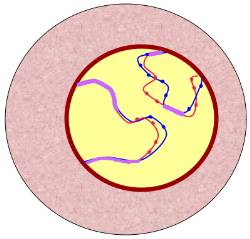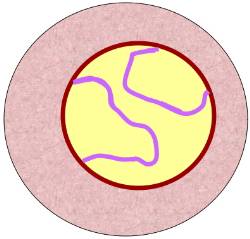Sketch, label and describe zygotene.

Early Zygotene 
Late Zygotene
Zygotene
During zygotene homologous chromosomes begin to unite (synapse) by coming into approximate alignment (zygo- is Greek for union, fusing, or yoking). Synapsis, the process of fusion that occurs between homologs begins at various points along the chromosome and extends outward, zipper-fashion, until complete. When synapsis is finished, the fused homologs look like a single chromosome under the light microscope, but they are actually double. The interface where two homologs unite, the synaptonemal complex, can be seen under an electron microcope.
In the diagram of early zygotene at right, the regions where the paternal and maternal homologs have fused is shown in purple. In the next diagram, representing late zygotene, both homolog pairs have fused over their entire lengths (so they are shown entirely in purple). Zygotene is also known as zygonema.
Tetrads: Once the homolog pairs synapse they are called tetrads (each has four chromatids; tetra is Greek for four) or bivalents. Bivalent is the preferred term, but tetrad is, nonetheless, the word more commonly used in most introductory biology classes. Bivalent is the better choice because there are equivalent names for other situations. For example, an unfused homolog is called a univalent. Three fused homologs, a common situation in plants, is called a trivalent, etc
 |
| Early Zygotene |
 |
| Late Zygotene |
Zygotene
During zygotene homologous chromosomes begin to unite (synapse) by coming into approximate alignment (zygo- is Greek for union, fusing, or yoking). Synapsis, the process of fusion that occurs between homologs begins at various points along the chromosome and extends outward, zipper-fashion, until complete. When synapsis is finished, the fused homologs look like a single chromosome under the light microscope, but they are actually double. The interface where two homologs unite, the synaptonemal complex, can be seen under an electron microcope.
In the diagram of early zygotene at right, the regions where the paternal and maternal homologs have fused is shown in purple. In the next diagram, representing late zygotene, both homolog pairs have fused over their entire lengths (so they are shown entirely in purple). Zygotene is also known as zygonema.
Tetrads: Once the homolog pairs synapse they are called tetrads (each has four chromatids; tetra is Greek for four) or bivalents. Bivalent is the preferred term, but tetrad is, nonetheless, the word more commonly used in most introductory biology classes. Bivalent is the better choice because there are equivalent names for other situations. For example, an unfused homolog is called a univalent. Three fused homologs, a common situation in plants, is called a trivalent, etc
